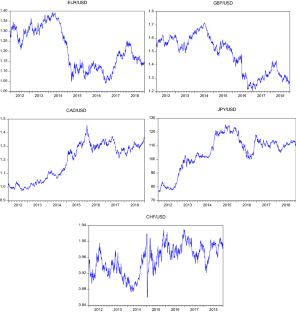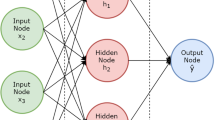Abstract
This study aims at examining the predictability of the autoregressive integrated moving average and deep learning methods consisting of the artificial neural network, recurrent neural network, long short-term memory (LSTM), and support vector machine. We will use these tools to estimate the parameters for predicting the accuracy of the foreign exchange returns. This study compares the forecasting performance between the autoregressive integrated moving average and deep learning methods. The comparison is based on the mean absolute percentage error, the root-mean-squared error, the mean absolute error, and Theil U. The empirical results indicate that the LSTM seems to outperform the other deep learning models as well as the traditional regression models.


Similar content being viewed by others
References
Babu AS, Reddy SK (2015) Exchange rate forecasting using ARIMA. Neural Netw Fuzzy Neuron J Stock Forex Trading 4(3):01–05
Bao W, Yue J, Rao Y (2017) A deep learning framework for financial time series using stacked autoencoders and long-short term memory. PLoS ONE 12(7):e0180944
Behar J (1995) Support vector machines. Learning 20:273–297
Bishop CM (1995) Neural networks for pattern recognition. Oxford University Press, Oxford
Box GE, Jenkins GM, Reinsel GC, Ljung GM (2015) Time series analysis: forecasting and control. Wiley, New York
Elman JL (1990) Finding structure in time. CognitSci 14(2):179–211
Friedman J, Hastie T, Tibshirani R (2001) The elements of statistical learning, vol 1, no 10. Springer series in statistics, New York
Galeshchuk S, Mukherjee S (2017b) Deep networks for predicting direction of change in foreign exchange rates. IntellSyst Account Finance Manag 24(4):100–110
Galeshchuk S, Mukherjee S (2017a) Deep learning for predictions in emerging currency markets. In: International conference on agents and artificial intelligence, vol 2. SCITEPRESS, pp 681–686
Hadjixenophontos A, Christodoulou-Volos C (2017) Predictability of foreign exchange rates with the AR (1) model. J Appl Finance Bank 7(4):39–58
Held L, Ott M (2018) On p-values and Bayes factors. Annu Rev Stat Appl 5:393–419
Khashei M, Bijari M (2010) An artificial neural network (p, d, q) model for time series forecasting. Expert SystAppl 37(1):479–489
Kim TY, Oh KJ, Kim C, Do JD (2004) Artificial neural networks for non-stationary time series. Neurocomputing 61:439–447
Kunze F (2020) Predicting exchange rates in Asia: New insights on the accuracy of survey forecasts. J Forecast 39(2):313–333
Mandic D, Chambers J (2001) Recurrent neural networks for prediction: learning algorithms, architectures, and stability. Wiley, New York
Maneejuk P, Yamaka W (2020) Significance test for linear regression: how to test without P-values? J Appl Stat 48:1–19
Menkhoff L, Taylor MP (2007) The obstinate passion of foreign exchange professionals: technical analysis. J Econ Lit 45(4):936–972
Ngan TMU (2013) Forecasting foreign exchange rate by using ARIMA model: a case of VND/USD exchange rate. Methodology 2014:2015
Parot A, Michell K, Kristjanpoller WD (2019) Using Artificial Neural Networks to forecast Exchange Rate, including VAR-VECM residual analysis and prediction linear combination. IntellSyst Account Finance Manag 26(1):3–15
Plakandaras V, Papadimitriou T, Gogas P (2015) Forecasting daily and monthly exchange rates with machine learning techniques. J Forecast 34(7):560–573
Qiu J, Wang B, Zhou C (2020) Forecasting stock prices with long-short term memory neural network based on attention mechanism. PLoS ONE 15(1):e0227222
Rout M, Majhi B, Majhi R, Panda G (2014) Forecasting of currency exchange rates using an adaptive ARMA model with differential evolution-based training. J King Saud Univ Computer InfSci 26(1):7–18
Ruby-Figueroa R, Saavedra J, Bahamonde N, Cassano A (2017) Permeate flux prediction in the ultrafiltration of fruit juices by ARIMA models. J MembrSci 524:108–116
Vapnik V (2013) The nature of statistical learning theory. Springer, Berlin
Yao J, Tan CL, Poh HL (1999) Neural networks for technical analysis: a study on KLCI. Int J TheorAppl Finance 2(02):221–241
Yue J, Zhao W, Mao S, Liu H (2015) Spectral–spatial classification of hyperspectral images using deep convolutional neural networks. Remote SensLett 6(6):468–477
Zhang G, Patuwo BE, Hu MY (1998) Forecasting with artificial neural networks: the state of the art. Int J Forecast 14(1):35–62
Acknowledgements
This research was supported by the Center of Excellence in Econometrics (CEE), Faculty of Economics, Chiang Mai University.
Author information
Authors and Affiliations
Corresponding author
Ethics declarations
Conflict of Interest
The authors declare no conflict of interest.
Additional information
Communicated by Vladik Kreinovich.
Publisher's Note
Springer Nature remains neutral with regard to jurisdictional claims in published maps and institutional affiliations.
Rights and permissions
About this article
Cite this article
Maneejuk, P., Srichaikul, W. Forecasting foreign exchange markets: further evidence using machine learning models. Soft Comput 25, 7887–7898 (2021). https://doi.org/10.1007/s00500-021-05830-1
Accepted:
Published:
Issue Date:
DOI: https://doi.org/10.1007/s00500-021-05830-1




